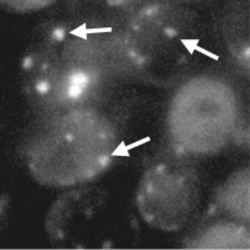Phase separation of a yeast prion protein promotes cellular fitness.
Despite the important role of prion domains in neurodegenerative disease, their physiological function has remained enigmatic. Previous work with yeast prions has defined prion domains as sequences that form self-propagating aggregates. Here, we uncovered an unexpected function of the canonical yeast prion protein Sup35. In stressed conditions, Sup35 formed protective gels via pH-regulated liquid-like phase separation followed by gelation. Phase separation was mediated by the N-terminal prion domain and regulated by the adjacent pH sensor domain. Phase separation promoted yeast cell survival by rescuing the essential Sup35 translation factor from stress-induced damage. Thus, prion-like domains represent conserved environmental stress sensors that facilitate rapid adaptation in unstable environments by modifying protein phase behavior.

- Science. 2018 Jan 5;359(6371)
- 2018
- Cell Biology
- 29301985
- PubMed
Enabled by:
